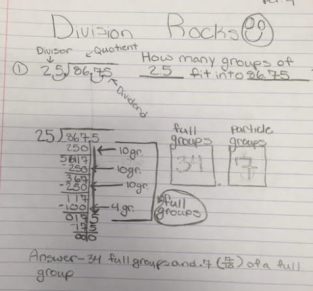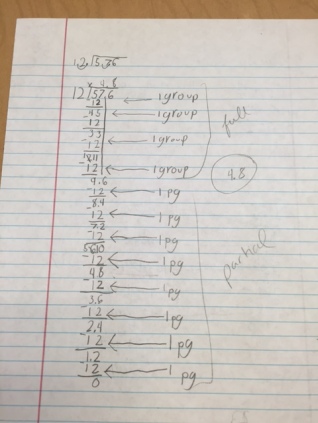For the past two years, I’ve heard many math educators push the idea of mathematical efficiency. The more I hear the word, efficient, the more I cringe for I feel its usage suggests:
- Students are thinking inefficiently in defiance.
- The algorithm is the most efficient strategy, therefore the best.
Let me explain…
Setting the Stage
A few weeks ago, I was teaching a 6th grade math class. I had been asked to demo a different way of dividing decimals. Even though I understood the method, this would be my first time teaching it to a group of students.
The teacher, special ed co-teacher and I understood we were entering a multi-dimensional learning zone.
- The students would be learning a new method
- I would be refining the pedagogical approach
- They would be gaining insights into both areas.
The Lesson
This was truly a spur of the moment lesson. After a lengthy discussion regarding the new method, the teacher simply asked: “Can you do this today in my classroom?”
I was so excited with this venture that I asked the students to title their paper, Division Rocks! The kiddos loved it and it helped me establish a “Let’s try something new” atmosphere. After reviewing vocabulary, the teacher turned the class over to me.
 Me: In your table groups, talk about how you’d say the given problem. The teachers and I circulated the room listening and clarifying mistakes.
Me: In your table groups, talk about how you’d say the given problem. The teachers and I circulated the room listening and clarifying mistakes.
- Me: After asking a student to state the problem out loud I asked, What does that mean?? We circulated again. I brought the class back and we discussed what students said.
- Me: Please fill out this sentence: How many groups of _____ fit into _____? We circulated again and acknowledged we were going to find the number of groups of 2.5 that fit into 86.75.
- Me: Since we are looking for groups, I have a question for you. How many groups of 25 fit into 867? Students shared their predictions. I chose to start with 10 groups.
- Me: Do you think 10 groups of 25 will fit into 867? Why or why not? We circulated again, listening and interacting with table groups. I brought the class back and called on students to share their thinking. As you can see in the picture, we continued using groups of 10 until 10 groups no longer worked. At that point, we let table groups determine their next step – the majority of the class (on their own) realized that 4 groups of 25 would work.
As a whole group, we acknowledged that 34 complete groups of 25 fit into 867 with a remainder of 17. Now it was time to address the partial group. The 5 was brought down and the students continued the process to find the partial group.
The final answer was:
- 34.7
- 34 groups of 25 and 7/10 of a group of 25 fit into 867.5
- 34 groups of 2.5 and 7/10 of a group of 2.5 fit into 86.75
*****************************************************************************
Efficiency vs Understanding
A good vibe filled the room. The class had bought into the new approach and we were excited to observe kids work more independently.
The problem: 5.78 divided by 1.2. aka How many groups of 1.2 fit into 5.78?
 Example #1: This student clearly understood the new process and he grouped efficiently. I was pleased to see he could transfer the new approach to a different problem, but this was not my ah -ha moment.
Example #1: This student clearly understood the new process and he grouped efficiently. I was pleased to see he could transfer the new approach to a different problem, but this was not my ah -ha moment.
 Example #2 (John): I was overjoyed to see this paper. Did he group “efficiently”? Nope. Did I care? Nope. By labeling his groups and partial group (pg), John provided evidence of understanding. He had a strategy and used it to arrive at the correct answer.
Example #2 (John): I was overjoyed to see this paper. Did he group “efficiently”? Nope. Did I care? Nope. By labeling his groups and partial group (pg), John provided evidence of understanding. He had a strategy and used it to arrive at the correct answer.
While this student was working, I saw one of the teachers look at his paper. She began to speak to the student …
- T: 12 can go into 57 more than 1 time…
- Me: I waved my hands for her to stop.
- T: Looks at me puzzled.
- Me: (mouths) Let him work.
- T: (mouths) Really?
- Me: I shook my head, “yes”
During the debrief, I explained why I asked her to back off.
My Reasoning: This was the first time students were practicing a new strategy on their own. John was making sense of the grouping concept. Even though he may not know the maximum times 12 goes into 57, he does know that 57 contains at least 1 group of 12. John was able to start the problem, and repeat a strategy which eventually lead him to the answer. He was successful.
I assumed John would’ve struggled with starting the problem had he been required to use the traditional algorithm. The two teachers confirmed my assumption and that’s when they had their ah-ha moment. I wish I had video of this momentous occasion! Their reaction was priceless.
They simultaneously concluded that John started and finished a division of decimals problem without any help – and he got the correct answer. It didn’t matter that his method took longer. It didn’t matter that his method can be viewed as inefficient. All that mattered was that John solved the problem and explained his process – something he couldn’t do before.
This particular division method is powerful. It’s designed to meet a student where he’s at and move him toward efficiency over time. Over time being the key component.
My Issue with Efficiency – Time and Exposure
John needs more exposure to this method of division before we start pushing his thinking. When I say exposure, I’m talking about opportunities to:
- Explain his thinking
- Listen to peers explain their thinking
- View peers’ work – same problem, different strategies.
- Practice more problems
- Ask questions
- Think and respond to posed questions, such as: “1 group of 12 can go into 57. How about 2 groups?”
I know what teachers are thinking … More exposure requires more time. I agree. BUT… Students forget procedures because they often aren’t given enough time and exposure to conceptually understand the mathematical reasoning behind the algorithms.
By rushing the conceptual understanding piece or skipping it altogether just to get to the “all mighty” algorithm, we deprive students of sense making opportunities – Therefore leaving them mathematically stranded.
John hasn’t worked with the material long enough to build connections and compress steps therefore he doesn’t possess the requisite skills needed to view the algorithm as efficient.
Bottom line: If a student doesn’t understand the algorithm, then it’s not his/her most efficient strategy. On the other hand, if that same student can solve a problem using a non-traditional method, then that’s his/her most efficient strategy.
Pingback: Dance Dance Transversal – A Guide | Communicating Mathematically
I love this! Thank you for sharing! I was sharing these messages with parents in my district and you’ve reminded me to get into more classrooms and make sure teachers understand, too.
LikeLike
Jennifer, thank you for reading!
One of my principals always says, “Success breeds success”. It’s an important idea to keep in mind when working with kids.
LikeLike
This is the best written explanation/example of not rushing to algorithm I have seen. Thank you for sharing Jenn. Convincing teachers,parents, and ourselves to trust this process is probably the single biggest on-going challenge we face in changing the way we approach the art of teaching.
LikeLike
Leeanne, thank you for reading and for your kind words!
LikeLike